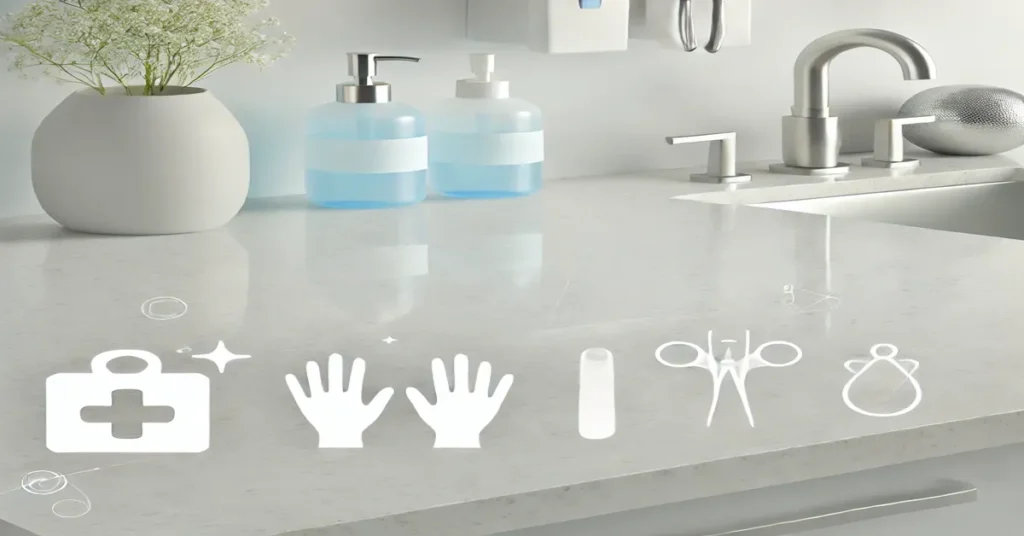Countertops play a crucial role in medical facilities, from hospitals and clinics to labs and dental offices. Beyond aesthetics, medical countertops must meet high standards of hygiene, durability, and functionality to support healthcare professionals and maintain patient safety. Whether in patient rooms, labs, or reception areas, choosing the right countertop material and design can significantly impact the efficiency and cleanliness of a medical environment medical countertop designs.
In this article, we’ll explore the importance of well-designed countertops in healthcare, the different materials commonly used, specific design considerations for medical environments, and emerging trends in medical countertop design. Additionally, we’ll discuss maintenance practices to keep surfaces sanitary and durable for years to come.
Why Medical Countertop Design Matters
Countertops in medical environments endure constant use and exposure to various substances, from disinfectants to bodily fluids, which makes durability and ease of cleaning essential. Medical countertops are critical not only for the practicality of healthcare spaces but also for providing a sanitary environment for patients and professionals. A well-thought-out countertop design can help streamline workflows, enhance aesthetic appeal, and ensure that safety standards are maintained.
Key Reasons Why Medical Countertop Design is Crucial:
- Hygiene and Infection Control: In a medical setting, hygiene is paramount. Countertop materials must be non-porous and easy to disinfect to prevent the spread of germs.
- Durability: Countertops in medical facilities are subject to frequent use, exposure to chemicals, and even medical instruments, so durability is critical to avoid damage and maintain a professional appearance.
- Functionality: A well-designed countertop helps create an efficient workspace, providing enough room for necessary equipment and supplies without causing clutter.
- Aesthetics and Patient Experience: In areas such as waiting rooms and patient consultation spaces, countertops should also be visually appealing to promote a calming and professional atmosphere for patients.
Types of Countertop Materials for Medical Environments
When choosing countertops for medical environments, not all materials are suitable due to the unique demands of healthcare spaces. Here’s a look at some of the best materials for medical countertops, focusing on durability, hygiene, and ease of maintenance.
1. Solid Surface Countertops
Solid surface materials are a popular choice for medical countertops due to their non-porous nature, which prevents bacteria and moisture from penetrating the surface. These materials can be seamlessly integrated with sinks and backsplashes, reducing crevices where bacteria might thrive.
- Advantages: Seamless, easy to clean, customizable, resistant to stains and chemicals.
- Disadvantages: Susceptible to scratches, which may require periodic refinishing.
2. Quartz Countertops
Quartz is a durable and non-porous material, making it ideal for medical environments. Unlike natural stone, quartz does not require sealing, and it’s highly resistant to stains, scratches, and heat. Its availability in various colors and designs allows for customization to match different facility aesthetics.
- Advantages: Non-porous, durable, resistant to chemicals, minimal maintenance.
- Disadvantages: Can be more expensive than other options.
3. Laminate Countertops
Laminate is a budget-friendly option that comes in a wide variety of designs. However, its durability may not match that of solid surface or quartz, and it’s less resistant to heavy impact. Modern laminate countertops are more resilient and easier to maintain than older versions, making them a viable choice for certain healthcare spaces.
- Advantages: Affordable, customizable, easy to clean.
- Disadvantages: Not as durable or resistant to chemicals; susceptible to scratches.
4. Stainless Steel Countertops
Stainless steel countertops are commonly used in labs and operating rooms due to their resistance to bacteria and chemical damage. They are non-porous and easy to clean, making them ideal for environments requiring strict hygiene standards.
- Advantages: Highly durable, resistant to bacteria and chemicals, easy to clean.
- Disadvantages: Can be noisy, cold appearance, susceptible to scratches and fingerprints.
5. Epoxy Resin Countertops
Epoxy resin countertops are commonly found in labs and research facilities. Known for their resistance to chemicals, heat, and bacteria, epoxy resin is a solid choice for medical environments that handle various substances and require robust surfaces.
- Advantages: Resistant to chemicals and heat, durable, non-porous.
- Disadvantages: Limited color options, can be expensive.
6. Granite Countertops
While not as common in medical settings, granite is sometimes used in areas where aesthetics are a priority, such as hospital reception desks. Granite is highly durable and can be sealed to make it more resistant to bacteria, but it requires regular maintenance.
- Advantages: Durable, aesthetically appealing.
- Disadvantages: Porous if not sealed, requires periodic maintenance.
Design Considerations for Medical Countertops
When selecting countertops for medical facilities, it’s essential to consider factors like functionality, safety, and ease of cleaning. Here are some design considerations that ensure the countertops meet the unique needs of healthcare environments:
1. Non-Porous Surfaces for Hygiene
Non-porous materials like quartz and solid surfaces are ideal for medical environments as they prevent liquids, bacteria, and other contaminants from penetrating the surface, which is essential for maintaining a sterile environment.
2. Seamless Edges and Backsplashes
Seamless edges and backsplashes are important because they minimize joints and crevices where germs could accumulate. For countertops integrated with sinks, a seamless design helps prevent water and debris from getting trapped.
3. Chemical and Stain Resistance
Medical countertops should withstand exposure to various chemicals, including cleaning agents, disinfectants, and occasionally biological substances. Choosing materials with high chemical resistance, such as epoxy resin or stainless steel, is essential in labs and clinical settings.
4. Ergonomics and Accessibility
Countertop heights and placements should be designed to accommodate different users, including healthcare staff and patients. Ergonomically designed countertops reduce strain on healthcare workers, especially in busy environments.
5. Aesthetic Appeal
While functionality and hygiene are the main priorities, aesthetics should not be overlooked, especially in patient-facing areas. A welcoming, well-designed countertop can contribute to a calming atmosphere, which is beneficial for patient satisfaction and comfort medical countertop designs.
6. Durability and Maintenance
Given the constant use and exposure to various substances, medical countertops need to be durable and low-maintenance. Materials like quartz and epoxy resin are resilient and require minimal upkeep, making them ideal choices for high-traffic areas.
Emerging Trends in Medical Countertop Designs
Healthcare design is continually evolving to meet the demands of modern medical facilities. Here are some current trends in medical countertop design:
1. Antimicrobial Surfaces
With a heightened focus on hygiene, antimicrobial countertops are becoming popular in healthcare. These surfaces inhibit the growth of bacteria and other pathogens, providing an added layer of safety in medical environments.
2. Sustainable Materials
Eco-friendly materials are gaining traction as hospitals and clinics aim to reduce their environmental impact. Sustainable countertop materials, such as recycled solid surfaces or responsibly sourced quartz, are being incorporated into healthcare facilities medical countertop designs.
3. Integrated Technology
The integration of technology into medical countertops is an emerging trend. Some facilities are experimenting with countertops embedded with charging ports, touch screens, or other tech enhancements to improve functionality for healthcare staff medical countertop designs.
4. Soft-Touch Surfaces
To create a more welcoming and less clinical atmosphere, some medical facilities are opting for countertops with soft-touch surfaces. These surfaces are less reflective and provide a warmer, more comfortable feel, making them ideal for waiting areas and consultation rooms medical countertop designs.
5. Color Psychology in Healthcare Design
Color psychology plays a role in healthcare design, with colors chosen to influence mood and reduce patient anxiety. Countertops in calming colors, such as soft greens and blues, are being incorporated into patient areas to foster a soothing environment.
Maintenance Tips for Medical Countertops
To ensure longevity and hygiene, medical countertops require proper maintenance. Here are some maintenance tips to keep surfaces in optimal condition:
- Daily Cleaning: Use a mild, non-abrasive cleaner for daily cleaning. Avoid using harsh chemicals unless necessary, as they can damage certain materials.
- Disinfection: Regularly disinfect countertops with a hospital-grade disinfectant to eliminate pathogens. Be sure to follow manufacturer instructions for each countertop material to avoid damage.
- Avoid Abrasive Tools: Avoid using abrasive sponges or cleaning tools, as they can scratch surfaces and create crevices where bacteria can hide.
- Promptly Clean Spills: Clean up spills immediately to prevent stains and damage. This is especially important for materials like granite, which can be porous.
- Periodic Inspections: Regularly inspect countertops for any signs of wear, chips, or cracks. Addressing damage early can prevent further issues and maintain a professional appearance.
- Sealing (if necessary): For materials like granite, ensure surfaces are sealed periodically to maintain their non-porous properties and resistance to bacteria.
Conclusion
In healthcare environments, countertop design is a critical component that impacts both functionality and patient safety. Materials like quartz, epoxy resin, and solid surfaces are favored for their durability, hygiene, and ease of maintenance. As healthcare design evolves, trends such as antimicrobial surfaces, sustainable materials, and integrated technology continue to shape medical countertop options, offering new ways to enhance functionality and aesthetics medical countertop designs.
By carefully selecting the right countertop material and design features, medical facilities can create workspaces that meet the high standards of the healthcare industry. In the long run, investing in quality countertops supports hygiene, productivity, and the overall experience of healthcare professionals and patients alike medical countertop designs.
Read: Loc n Gel: Essential Styling Solution for Natural Hair and Locs
FAQs
1. What are the best materials for medical countertops?
The best materials for medical countertops are non-porous, durable, and easy to clean. Popular options include quartz, solid surfaces, epoxy resin, and stainless steel.
2. How do I maintain medical countertops?
Regular cleaning, disinfection, and avoiding abrasive tools are key to maintaining medical countertops. Materials like granite may also require periodic sealing.
3. Can I use natural stone in a medical environment?
While natural stone like granite can be used in certain areas, it’s essential to seal it to make it more resistant to bacteria. Non-porous materials are generally preferred.
4. What are antimicrobial countertops?
Antimicrobial countertops are surfaces designed to inhibit the growth of bacteria and pathogens, offering an additional layer of hygiene in medical settings.
5. How do I choose the right countertop height in a medical facility?
Consider ergonomic and accessibility requirements to ensure the countertop height accommodates both healthcare workers and patients comfortably.
6. What role does color play in medical countertop design?
Color psychology in healthcare settings can influence patient mood. Soft colors like greens and blues are often chosen for patient areas to create a calming atmosphere.







